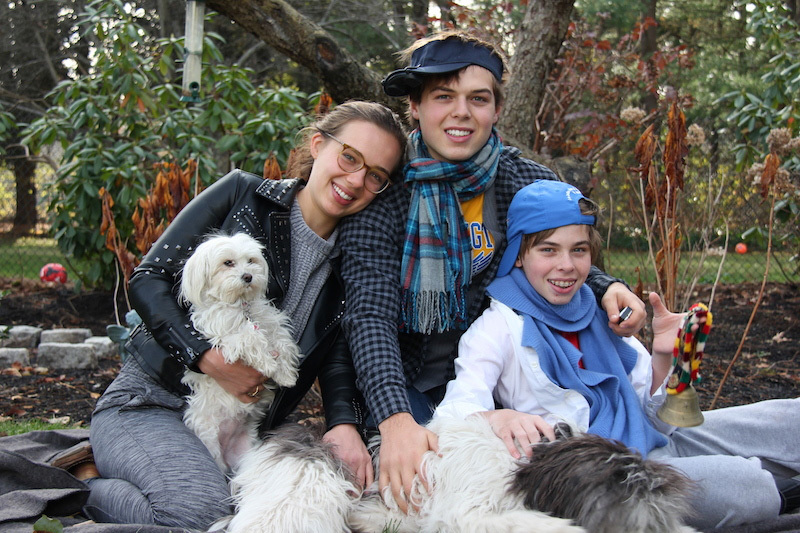How coronavirus has changed us: One family’s story

“Albert — what’s the matter? Stop that barking!” In his typical territorial manner, my sheepdog patrols the neighborhood. I look out the window to see what’s got him worked up.
Outside, I see my 15-year-old son and my 80-year-old mom walking down the street. This seemingly ordinary sight is actually anything but ordinary for our family. My mom lives in Southern California, and my son is usually much more interested in playing Fortnite than walking with his grandmother. But our family, like the rest of the world, is changing our behavior and adapting to self-quarantine.
Self-quarantine: A new normal
My mom flew from California to Massachusetts to watch my son’s robotics tournament. She was planning to fly back home to my dad right when coronavirus-related travel warnings were being posted. A debate ensued: At 80 years old, should she risk flying cross country? What if she was exposed and brought the virus back to my 82-year-old dad, who has heart disease? In the end, it seemed safest to curtail her travel. Little did we know she would be here for weeks.
My 15-year-old son has a heart condition and is allergic to almost all classes of antibiotics. Thankfully, the statistics look pretty good for his age group, but still we are cautious. Like the rest of us, he is staying safe through social distancing. Walking with his grandmother seems to be a safe activity.
Making tough choices
Since coronavirus started spreading, life has changed for all the members of our family. My older son is 20. I would like him to stay home but he resists. Instead, he has become our self-appointed errand person. He runs to the grocery store or pharmacy to help decrease the exposure risk for the high-risk family members.
We’ve worked out a plan where he can come and go through his first-floor bedroom window so he isn’t walking through the house and potentially spreading the virus. I bring his food to his bedroom door. He is restricting his movements in the house because the rest of us can’t risk the potential exposure he has taken on. Yes, you read that right: My son is now going in and out of the house through a window.
Up until New York’s stay-at-home order, my 23-year-old daughter was working on a trading floor in New York City. Three of her coworkers tested positive for COVID 19. Unfortunately, despite over a week of fever, fatigue, and cough, she was not able to get tested back then. She is now feeling better but is unable to smell — a reported symptom of COVID 19. I wish I could have been there to help her, but I couldn’t risk bringing coronavirus home to my younger son or mom.
Providing support, staying flexible
These days, it seems all of the rules have changed. As parents, we are all trying to navigate the line between providing support, structure, and stability for our kids while remaining calm and flexible given our changing circumstances. We need to help keep our children safe physically while understanding and trying to accommodate their needs as teenagers to connect with their peers and maintain their sense of autonomy. We are balancing the health and well-being of not only our family members but our communities at large.
Did I think a day would come where my son runs the household errands and comes and goes through a window? When my kids’ schools are all closed and the adults are trying to work from home? When I actually encourage my son to play Fortnite with his peer group to stay connected? When I have to teach my family members how to properly wash their hands, sanitize doorknobs, and stay at least six feet away from anyone not in our immediate family?
I never imagined parenting under these circumstances. But I also never imagined a day when my 15-year-old son would text his grandmother and ask to go on a walk. Watching them, I’m reminded that even in the midst of unprecedented lifestyle changes, we will adapt and find small moments of unexpected pleasure.
Katie Nill is the mother of two sons, one daughter, and two dogs. All three of her children are patients at Boston Children’s Hospital. She works as an adolescent therapist and is a member of the Boston Children’s Family Advisory Council. If you bump into her when the world is up and running again, feel free to ask about all her crazy quarantine stories.
Get more answers about Boston Children’s response to COVID-19.
Related Posts :
-

Model enables study of age-specific responses to COVID mRNA vaccines in a dish
mRNA vaccines clearly saved lives during the COVID-19 pandemic, but several studies suggest that older people had a somewhat reduced ...
-

New insight into the effects of PPIs in children
Proton-pump inhibitors (PPIs) are frequently prescribed to suppress stomach acid in patients with gastroesophageal reflux disease (GERD). Prescribing rates of ...
-

Creating the next generation of mRNA vaccines
During the COVID-19 pandemic, mRNA vaccines came to the rescue, developed in record time and saving lives worldwide. Researchers in ...
-

Reversing the trend: Easing the mental health boarding crisis in emergency rooms
Anxiety, depression, and suicide attempts have been rising over the past decade, especially among teens, often landing them in emergency ...





